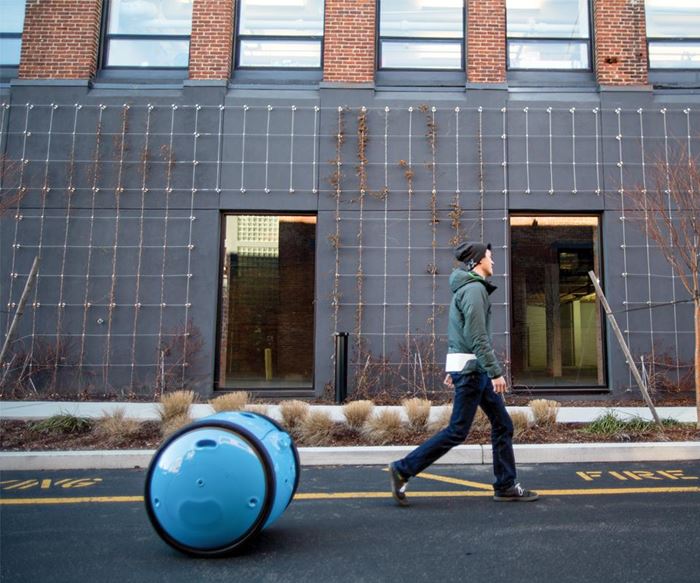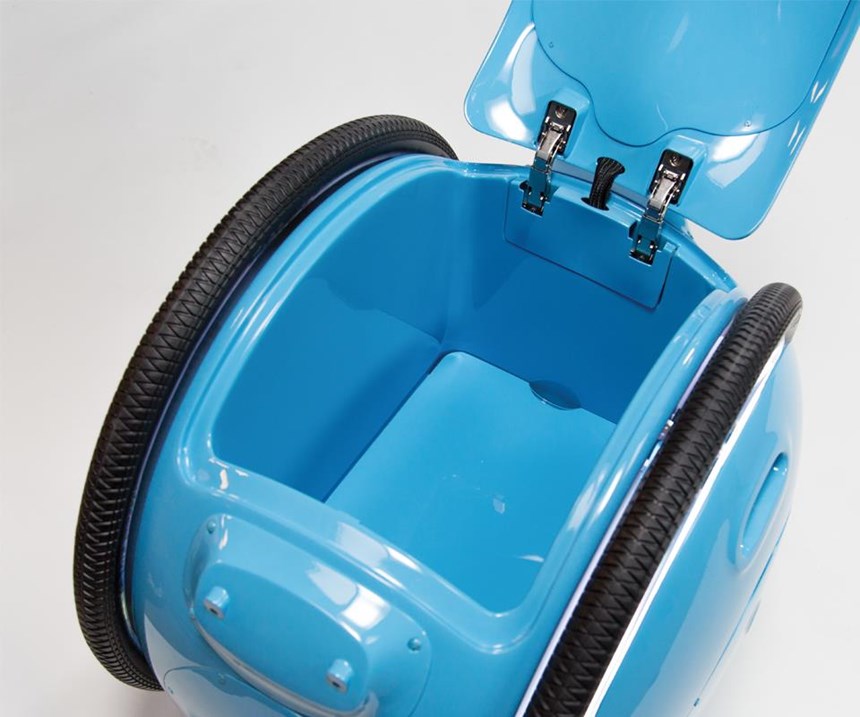Composites in transit: Rolling robotic “stuff carrier” the new must-have
PPF’s Gita can move at a human walking pace or can accelerate up to 35 kph, fast enough to keep pace with a runner.
What should hip urban dwellers do when they need to pick up a week’s groceries or carry a big briefcase of documents home from the office, but don’t own a car and can’t find a taxi or Uber (or an aerial drone)? Piaggio Fast Forward (PFF, Boston, MA, US) could have the answer. Founded in 2015 by the Piaggio Group, the maker of the iconic Vespa motor scooter and other two- and three-wheeled vehicles, PPF’s stated goal is to “create lightweight, intelligent and autonomous mobility solutions for people and goods.” Architectural composites innovator Greg Lynn, PFF’s co-founder and chief creative officer, saw a trend: “People were moving less, and more things were being brought to them. We see an alternative vision, where robotic solutions can help people move more, by carrying and following. It makes your hands free so you can do more with your hands, and you can walk or run further, longer.”
The first PFF product prototype, introduced in February of this year, is the Gita (pronounced “gee-ta,” Italian for “short trip”). Gita is a 0.67m diameter, smart, wheeled robotic cargo vehicle, with an 18-kg payload. Equipped with an optical detection system and sensors, it creates a three-dimensional map of its surroundings, with waypoints, while following a human, who wears a camera device. Once Gita knows a route, it can operate autonomously in some environments or in a convoy mode with other Gita devices, or in tandem with the Kilo, a larger PPF-designed robotic vehicle that has a 91-kg capacity.
Instead of streets filled with autonomous cars, PFF imagines people walking, biking or skating with their robots handling the heavy lifting. PPF’s Gita (pictured above) can move at a human walking pace or can accelerate up to 35 kph, fast enough to keep pace with a runner.
Lynn tells CW that PFF is currently building high-performance working prototypes of the Gita, and can’t yet discuss its industrialized production plans. But the company has built 12 prototypes, the first six in carbon fiber and six more in carbon fiber/fiberglass. Prototype composite tooling was created by Symmetrix Composite Tooling (formerly mould-CAM US, Bristol, RI, US) from machined foam patterns for the cylinder barrel, the domed cylinder ends, and cargo area or “column.” Parts were wet-laminated and vacuum-consolidated, some by New England Boatworks (Portsmouth, RI, US) and the rest by PFF, in-house. “We switched to fiberglass cover panels and cargo structure for the newer prototypes because we needed to have better transmission through areas of the vehicle for the electrical signals,” says Lynn.
Almost all other details, mounts and additional parts that bond to Gita’s body or structure are 3D-printed, carbon-reinforced nylon parts (some with chopped and others with continuous carbon fiber) built with in-house Markforged (Somerville, MA, US) printers, and other printers that also use chopped fiber in nylon, says Lynn. “We were able to very rapidly build working prototypes at a very high quality and with the weight and strength of production parts by working with the composites industry in the Bristol, RI area,” he adds, “as well as using the robotics we have in-house to make our own CNC-shaped molds and laminating our own parts in-house.”
Related Content
Cutting 100 pounds, certification time for the X-59 nose cone
Swift Engineering used HyperX software to remove 100 pounds from 38-foot graphite/epoxy cored nose cone for X-59 supersonic aircraft.
Read MoreBladder-assisted compression molding derivative produces complex, autoclave-quality automotive parts
HP Composites’ AirPower technology enables high-rate CFRP roof production with 50% energy savings for the Maserati MC20.
Read MoreActive core molding: A new way to make composite parts
Koridion expandable material is combined with induction-heated molds to make high-quality, complex-shaped parts in minutes with 40% less material and 90% less energy, unlocking new possibilities in design and production.
Read MoreTroubleshooting thermoplastic composite stamp forming
Understand the basic science of TPC stamp forming, a manufacturing process steadily gaining momentum in aerospace and mobility applications thanks to its rapid forming, short cycle times and automated methods.
Read MoreRead Next
Ultrasonic welding for in-space manufacturing of CFRTP
Agile Ultrasonics and NASA trial robotic-compatible carbon fiber-reinforced thermoplastic ultrasonic welding technology for space structures.
Read MoreNext-gen fan blades: Hybrid twin RTM, printed sensors, laser shock disassembly
MORPHO project demonstrates blade with 20% faster RTM cure cycle, uses AI-based monitoring for improved maintenance/life cycle management and proves laser shock disassembly for recycling.
Read MoreCeramic matrix composites: Faster, cheaper, higher temperature
New players proliferate, increasing CMC materials and manufacturing capacity, novel processes and automation to meet demand for higher part volumes and performance.
Read More
























